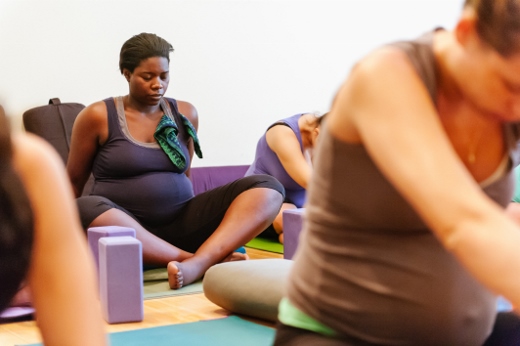Not long ago, I was sitting having lunch with my dear friend Michele discussing everything from kids, to marriage, to work. We eventually made it to the subject of yoga. I met Michele nearly 10 years ago when she and her super tight hamstrings ventured into the Prenatal Yoga Center for what would be one of her first yoga classes. While her shadow does not cast our hallowed halls anymore, I was thrilled to discover she has made it back to yoga elsewhere.
I asked her what drew her back to it since I know she had not practiced in a while. She explained that it was the physical compliment to her work as a psychotherapist. This intrigued me. “How?” I asked. Her answer was so brilliantly simple, “Yoga asks you to sit with your discomfort.” “Yes. Exactly,” I replied. She went on to describe in her role as a psychotherapist, she will notice when a client will mention something uncomfortable or painful and then immediately switch subjects. She explained, in these situations she would say something to the extent of, “I noticed you moved away from this topic. Let’s go back and talk about this a little more.” She is asking the client to return to the place of discomfort, dive deeper and explore this subject, even if it is difficult.
Yoga asks the same of its practitioners. While many people may initially come to yoga to build strength and flexibility, the majority of people discover the results beyond the physical experience and uncover a spiritual development of finding the connection of mind and body. This development often carries some growing pains. Yoga asana can release emotional triggers that can be overwhelming to process immediately. It is not uncommon for a student to cry in class. Also in terms of sitting with discomfort, the physical act of the asana can often be challenging to face, whether it be mustering the strength and stability to stay in a pose or the ability to relax into it so the muscles can release. From a personal experience, I have been in poses that are simply hard for me. My first reaction is to come out of it immediately and avoid the poses in the future. That is why when I do roll out my mat for a home practice, I have to be very disciplined not to just roll around on the floor and do what feels good. (Well, every now and then I do enjoy a very feline like practice.) But for the most part, I work to explore the boundaries of my body and mind within the pose. And when I have the knee jerk reaction to come out of a pose, I ask myself, “Why do I want to escape this pose? Can I simply face this experience breath by breath until it passes?” The answer with practice is, “Yes.”
What is the result of practice?
Several years ago, I came across a relatively small study conducted in Thailand of approximately 80 pregnant participants. The pregnant people were broken into two groups- one being a control group who did not practice prenatal yoga and the other group who attended six 1-hour yoga classes, one every 2 weeks in their final trimester. The results of the study show extremely positive results for the pregnant yoginis. In particular, yoga movements, breathing, and chanting may increase circulating endorphins and serotonin, …raising the threshold of mind-body relationship to pain.” (1)
When we allow ourselves to encounter obstacles in our yoga practice, it can open us up to learning how to cope with challenges and obstacles off the mat. In a yoga class, we have the luxury to come out of the pose if our emotions or phyisical discomfort start to become overwhelming. However, in the middle of a contraction or in the midst of an overtired, crying baby, there is only one way to get to the other side: gather the strength to get through it, know it will pass, and surrender to the discomfort of the moment. Next time you encounter a pose that makes you want to run for the hills, ask yourself, “What am I avoiding and is it possible to sit within my discomfort for just a little bit longer?”







